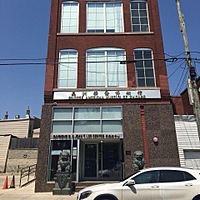Chinese American Museum of Chicago facts for kids
| Chinese American Museum of Chicago | |||||||
|---|---|---|---|---|---|---|---|
| Traditional Chinese | 美洲華裔博物館 | ||||||
| Simplified Chinese | 美洲华裔博物馆 | ||||||
|
|||||||
The Chinese American Museum of Chicago (CAMOC) is a special place. It helps people learn about Chinese American culture. The museum shares stories through exhibits, education, and research. It also works to save the history of Chinese Americans. This is especially true for those living in the American Midwest.
The museum first opened in 2005. It is located in Chicago's Chinatown neighborhood. In 2008, a fire caused a lot of damage. But the museum was rebuilt and reopened in 2010. It is now called the Raymond B. & Jean T. Lee Center. The Chinatown Museum Foundation (CMF) runs CAMOC. This foundation is a non-profit group in Chicago, Illinois.
Contents
History of the Museum
The building where the museum is located is quite old. It was built in 1896. First, it was used as a warehouse. Later, it became home to the Quong Yick Co.
In September 2008, a big fire damaged the museum. It had to close for a while. Raymond B. Lee's family used to run a food business in the building. He donated a lot of money to buy the building. This helped start the museum.
Mr. Lee even slept on the third floor when he was a teenager. He also gave more money for repairs after the fire. Thanks to these efforts, the museum reopened in 2010. It was ready to welcome visitors again.
What You Can See Now
The museum has some amazing exhibits. They help you learn about Chinese American history.
- "Great Wall to Great Lakes: Chinese Immigration to the Midwest" is a permanent exhibit. You can find it on the second floor. It tells how Chinese immigrants came to America. It explains why they traveled across the country. Many settled in the Midwest, including Chicago.
- "My Chinatown: Stories from Within" is another permanent exhibit. It is a 16-minute video on the second floor. This video shares stories from people in Chinatown. It covers their journeys, customs, and family life. The Chicago History Museum helped create this video.
- "Attic Treasures II" is a temporary exhibit on the first floor. It shows many objects that were not seen before. These items were lovingly saved by families over many years. You can see old furniture, photos, and paintings. There are also beautiful jewelry pieces and teapots. During the COVID-19 pandemic closures, the museum offered a virtual tour of this exhibit.
Exhibits from the Past
The museum often changes its temporary exhibits. This brings new stories and items to see.
- "The Way We Wore: Celebrating Chinese Fashion Heritage" was a temporary exhibit. It showed Chinese fashion history. Many items were donated or loaned by the Chinese community. This included family photos and personal jewelry. The exhibit closed in February 2019.
- "The Chinese Helped Build the Railroad–The Railroad Helped Build America" was another temporary exhibit. It focused on a very important part of history. Chinese immigrants played a huge role in building America's first Transcontinental Railway. This happened in the 1800s. The exhibit featured photos by Li Ju. It honored about 12,000 Chinese workers. They helped complete the railway. The exhibit also showed what their daily life was like. This project was supported by Stanford University and other groups. It opened in March 2019.
Fun Events
The museum hosts special events throughout the year. These events celebrate Chinese culture.
Chinese New Year Celebration
Every year, the museum holds a Chinese New Year Celebration. It is a very exciting event! You can enjoy live Chinese traditional music. There are also lion dances and Chinese chess games. You can even see calligraphy design. Of course, there is delicious food too! In 2021, the celebration was held online. This was due to the COVID-19 pandemic.
See also
- Chinese in Chicago
- Weaverville Joss House State Historic Park
- Chinese American Museum
- Museum of Chinese in America
- Chinese Historical Society of Southern California
- Chinese Culture Center


